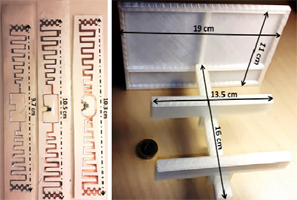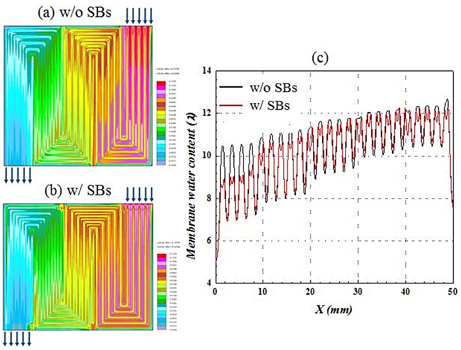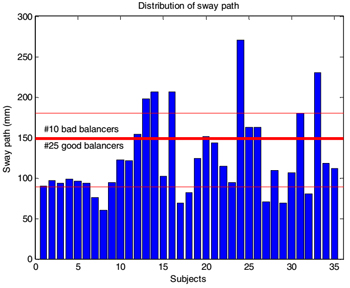Best Paper Award Nominees
Best Paper Award Patron: PluratoIoT symposium track
Design of UHF RFID Devices Based on 3D-Printing Technology
Luca Catarinucci and Riccardo Colella (University of Salento, Italy)
 The joint use of Radiofrequency Identification (RFID) technology with 3D-printed structures is very appealing for designing new RFID-based smart devices while maintaining cost-effectiveness. In this work a T-Resonator structure for the dielectric characterization of substrates, including 3D-printed ones, is firstly presented. Both permittivity and loss tangent of PLA substrates have been measured in the UHF RFID band when varying the air percentage in the printed material. On the basis on the characterized substrates, a wearable bracelet tag and a Yagi-Uda-inspired long-range tag, which exploit the peculiarities of 3D-printing, have been designed, realized, and validated.
The joint use of Radiofrequency Identification (RFID) technology with 3D-printed structures is very appealing for designing new RFID-based smart devices while maintaining cost-effectiveness. In this work a T-Resonator structure for the dielectric characterization of substrates, including 3D-printed ones, is firstly presented. Both permittivity and loss tangent of PLA substrates have been measured in the UHF RFID band when varying the air percentage in the printed material. On the basis on the characterized substrates, a wearable bracelet tag and a Yagi-Uda-inspired long-range tag, which exploit the peculiarities of 3D-printing, have been designed, realized, and validated.
Energy track
Role of under-rib convection in in situ reactant and liquid water flows and current density distributions for polymer electrolyte membrane fuel cells
Vinh Nguyen Duy, Kanghoon Park and Hyung-Man Kim (INJE University, Korea)
 Novel flow-field approach by the under-rib convection (URC) aims to enhance polymer electrolyte membrane fuel cell (PEMFC) performance. This study presents the experimental and numerical results for single cells with a new serpentine flow-field (SFF) that stimulates URC by adding sub-channels and bypasses (SBs) to a conventional flow-field with five passes and four turns on an active area of 25 cm2. To characterize the role of under-rib convection for PEMFC performance, the performance-related parameters of the SFF with SBs are compared experimentally and numerically with those of conventional SFF without SBs. In the experimental evaluation of PEMFC performance, the area of the lower current density with the SFF without SBs become broader than that with the SFF with SBs. In the case of the SFF without SBs, the sub-channel changes the flow direction of the URC and the URC flow direction converges to the sub-channel. The enhancement of URC can reduce water flooding at the cathode and increase the electrochemical reaction, thus improving both the cell performance and the operating stability. URC would play an important role in improving PEMFC performance, as well as increasing the fuel cell lifetime.
Novel flow-field approach by the under-rib convection (URC) aims to enhance polymer electrolyte membrane fuel cell (PEMFC) performance. This study presents the experimental and numerical results for single cells with a new serpentine flow-field (SFF) that stimulates URC by adding sub-channels and bypasses (SBs) to a conventional flow-field with five passes and four turns on an active area of 25 cm2. To characterize the role of under-rib convection for PEMFC performance, the performance-related parameters of the SFF with SBs are compared experimentally and numerically with those of conventional SFF without SBs. In the experimental evaluation of PEMFC performance, the area of the lower current density with the SFF without SBs become broader than that with the SFF with SBs. In the case of the SFF without SBs, the sub-channel changes the flow direction of the URC and the URC flow direction converges to the sub-channel. The enhancement of URC can reduce water flooding at the cathode and increase the electrochemical reaction, thus improving both the cell performance and the operating stability. URC would play an important role in improving PEMFC performance, as well as increasing the fuel cell lifetime.
Health track
Methodological approach in prediction of balance with machine learning applied on fMRI data
Ranjith Steve Sivagnanaselvam (University of Fribourg, Switzerland); Dominique Genoud (University of Applied Sciences Western Switzerland, Switzerland); Wolfgang Taube (University of Fribourg, Switzerland)
 Machine learning is a useful method to assess biomedical data. However, due to the complexity of these data, it is important to rely on a robust methodology. Predictions with machine learning are not only an add-on to statistical analysis but are a real process of discovering and establishing clinical validity of the diagnostic techniques. This paper describes a machine learning approach to predict balance changes in seniors based on functional magnetic resonance imaging (fMRI) data. Functional MRI results in a huge amount data containing some noise. Thus, a noise filtering technique is proposed and subsequent analyses are conducted with various machine learning algorithms. The best prediction of the balance ability based on brain activation patterns was obtained by applying a neural network approach. This resulted in an area under the curve (AUC) of 0.91. Other learning algorithms such as the tree ensemble are less predictive but allow tracking and better understanding of the source of differentiation. The results are based on a real dataset
Machine learning is a useful method to assess biomedical data. However, due to the complexity of these data, it is important to rely on a robust methodology. Predictions with machine learning are not only an add-on to statistical analysis but are a real process of discovering and establishing clinical validity of the diagnostic techniques. This paper describes a machine learning approach to predict balance changes in seniors based on functional magnetic resonance imaging (fMRI) data. Functional MRI results in a huge amount data containing some noise. Thus, a noise filtering technique is proposed and subsequent analyses are conducted with various machine learning algorithms. The best prediction of the balance ability based on brain activation patterns was obtained by applying a neural network approach. This resulted in an area under the curve (AUC) of 0.91. Other learning algorithms such as the tree ensemble are less predictive but allow tracking and better understanding of the source of differentiation. The results are based on a real dataset
